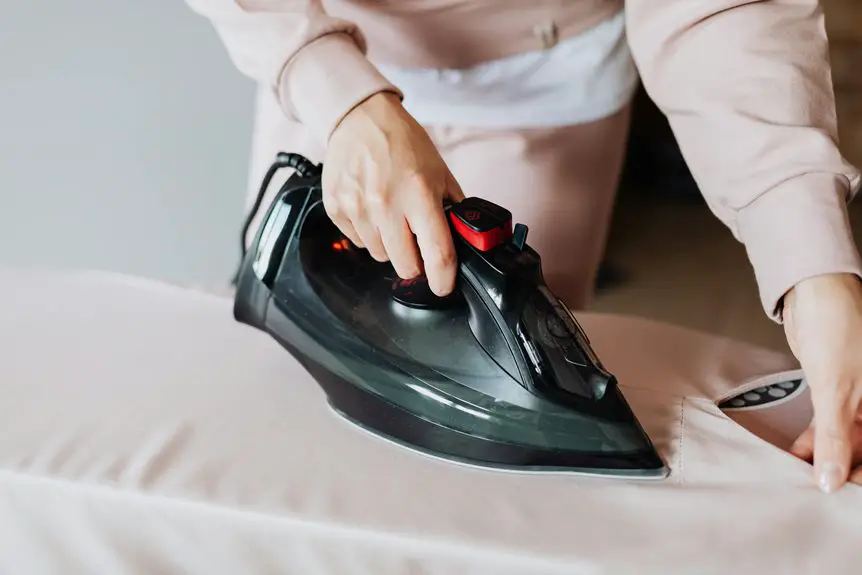Yes, steam cleaning can effectively remove fabric odors. By using high-temperature steam, it breaks down and sanitizes the fibers. This powerful method penetrates deep into the material, eliminating odor-causing bacteria without harsh chemicals. It’s suitable for various fabrics and enhances their freshness. However, some stubborn odors might require additional treatment. If you’re curious about the best practices for steam cleaning and maintaining that fresh smell, there’s more to explore.
Table of Contents
Key Takeaways
- Steam cleaning effectively breaks down odor molecules in fabric, refreshing and sanitizing materials without chemicals.
- High-temperature steam penetrates deep into fibers, eliminating bacteria and allergens that cause unpleasant smells.
- While steam cleaning can remove many odors, stubborn smells may require additional treatments for complete eradication.
- Certain delicate fabrics may be damaged by steam; always check care labels before steam cleaning.
- Quick drying after steam cleaning helps prevent mold growth, reducing the risk of new odors forming.
Understanding Fabric Odors
Fabric odors can be a frustrating issue, often stemming from sweat, spills, or environmental factors. You might notice unpleasant smells lingering in your favorite clothes, upholstery, or linens.
Fabric odors often arise from sweat, spills, or environmental factors, leaving unpleasant smells in clothes, upholstery, and linens.
These odors can cling to fabric fibers, making it difficult to eliminate them through regular washing. Bacteria and mold can thrive in damp conditions, exacerbating the problem and leading to musty scents.
Additionally, certain materials, like polyester and nylon, tend to trap odors more than natural fibers. If you don’t address these issues promptly, the smells can become more entrenched over time.
Understanding the sources of these odors is essential, as it helps you choose the right cleaning method to tackle the problem effectively and restore freshness to your fabrics.
The Science of Steam Cleaning
When it comes to tackling stubborn fabric odors, steam cleaning offers a powerful solution grounded in science. The process utilizes high-temperature steam, which penetrates fabric fibers to help break down odor molecules.
As the steam heats the material, it loosens dirt, bacteria, and allergens that contribute to unpleasant smells. The combination of heat and moisture creates an environment that makes it difficult for odor-causing agents to survive.
Additionally, the steam can help to sanitize fabrics, killing germs and bacteria that might be lurking within. This effective method not only refreshes your fabrics but also enhances their longevity.
How Steam Cleaning Works
Steam cleaning operates by converting water into high-pressure steam, which is then applied to fabrics and surfaces. This process involves heating water in a boiler until it vaporizes.
When the steam is released, it penetrates deep into the fibers of the material, loosening dirt, grime, and odors. As you move the steam cleaner across the surface, the hot steam helps to sanitize and refresh, effectively breaking down contaminants.
The steam’s high temperature kills bacteria, dust mites, and allergens, making it a powerful cleaning method. The moisture evaporates quickly, leaving surfaces damp but not soaked.
Benefits of Using Steam Cleaning for Odor Removal
While many cleaning methods struggle to eliminate stubborn odors, steam cleaning shines as an effective solution. It uses high temperatures to penetrate fabric fibers, breaking down odor-causing particles without harsh chemicals. This makes it safe for both your family and the environment. Plus, steam cleaning sanitizes surfaces, killing bacteria and allergens that contribute to unpleasant smells.
| Benefits | Details |
|---|---|
| Deep Clean | Reaches deep into fibers, removing odors. |
| Chemical-Free | Uses only water, safe for sensitive areas. |
| Quick Drying | Evaporates quickly, preventing mold growth. |
| Versatile | Suitable for various fabrics and surfaces. |
| Allergen Reduction | Eliminates dust mites and allergens effectively. |
Experience these benefits for yourself and enjoy fresher, cleaner fabrics!
Types of Fabrics Suitable for Steam Cleaning
When considering steam cleaning, it’s crucial to know which fabrics can handle the heat and moisture.
Natural fibers like cotton and wool often benefit from steam, while synthetic fabrics typically show good compatibility.
However, you should exercise caution with delicate materials, as they may not withstand the process.
Natural Fibers Benefits
Natural fibers, like cotton, linen, and wool, offer excellent benefits when it comes to steam cleaning. These fabrics are highly breathable, which allows steam to penetrate effectively, loosening dirt and odors.
You’ll find that steam cleaning not only sanitizes but also refreshes your natural fiber items without harsh chemicals. Plus, they’re generally more durable under steam treatment compared to synthetic options.
You can confidently tackle stubborn smells and stains, knowing you’re preserving the integrity of the fabric. Additionally, natural fibers tend to dry quickly, minimizing the risk of mildew.
If you’ve got furniture, curtains, or clothing made from these materials, steam cleaning is a safe and effective choice to keep them looking and smelling fresh.
Synthetic Fabrics Compatibility
Although steam cleaning is often associated with natural fibers, many synthetic fabrics can also benefit from this method.
Fabrics like polyester, nylon, and acrylic are typically safe for steam cleaning. These materials are durable and can handle the heat and moisture without damage.
When you steam clean synthetic fabrics, you not only eliminate odors but also refresh their appearance. It’s important to check the care label before proceeding, as some blends may have specific instructions.
Generally, steam cleaning can help remove stubborn stains and allergens from these fabrics, making your items feel cleaner and more inviting.
Just make sure to keep the steam nozzle at a safe distance to avoid any potential melting or distortion.
Delicate Materials Caution
While steam cleaning can be an effective method for many fabrics, you should exercise caution with delicate materials.
Fabrics like silk, lace, and certain types of wool may not respond well to high heat and moisture. The steam can weaken fibers, leading to damage or distortion. Before you proceed, always check the care label. If it suggests dry clean only, it’s best to avoid steam cleaning altogether.
For fabrics like chiffon or tulle, a quick steam might be okay, but keep the nozzle at a distance to prevent saturation. If you’re unsure, test a small, inconspicuous area first.
Limitations of Steam Cleaning
Even though steam cleaning is an effective method for tackling dirt and grime, it has its limitations when it comes to removing fabric odors.
While steam can kill bacteria and refresh materials, it doesn’t always penetrate deeply enough to eliminate stubborn odors, especially those embedded in the fibers over time.
If the odor is caused by mold or mildew, steam cleaning mightn’t fully eradicate the source.
Additionally, certain fabrics, like silk or leather, can be damaged by high heat and moisture.
You also need to take into account that steam cleaning can leave behind moisture, which might lead to new odors if not dried properly.
Consequently, while it’s a useful tool, steam cleaning isn’t a guaranteed solution for all fabric odor issues.
Step-by-Step Guide to Steam Cleaning Fabrics
Steam cleaning fabrics can be a straightforward process if you follow these simple steps.
First, gather your steam cleaner, a clean cloth, and any necessary attachments.
Next, check the care label on your fabric to verify it’s steam-cleanable. Pre-treat any stains with a fabric-safe cleaner.
Check the care label to ensure your fabric is safe for steam cleaning and pre-treat any stains beforehand.
Then, fill the steam cleaner with water and let it heat up.
Once ready, test a small, inconspicuous area of the fabric to confirm there’s no discoloration.
Start steaming from one end to the other in even strokes, keeping the nozzle a few inches away.
After steaming, allow the fabric to dry completely before use.
Finally, vacuum the area to lift any loosened dirt or debris, verifying your fabric smells fresh and clean.
Comparing Steam Cleaning With Other Cleaning Methods
When it comes to tackling fabric odors, you might wonder how steam cleaning stacks up against other methods.
It’s essential to take into account effectiveness, chemical use, and the time you’ll spend cleaning.
Let’s break down these factors to see which approach best suits your needs.
Effectiveness Against Odors
While many cleaning methods claim to tackle stubborn odors, steam cleaning stands out for its ability to penetrate deep into fabrics.
This method not only cleans the surface but also eliminates odor-causing bacteria and allergens that other methods might leave behind.
Here’s how steam cleaning compares to other techniques:
- Hot Water Extraction: Similar to steam cleaning but may not reach the same temperature for ideal odor removal.
- Dry Cleaning: Often relies on chemicals, which can mask odors rather than eliminate them.
- Vacuuming: Effective for dust and debris but won’t tackle embedded odors.
- Spot Cleaning: Targets specific stains but mightn’t address the overall smell of the fabric.
Chemical Use Comparison
Although many cleaning methods utilize harsh chemicals, steam cleaning offers a safer alternative by relying solely on high-temperature steam.
Unlike traditional cleaning methods that use detergents, bleach, or other synthetic agents, steam cleaning eliminates the need for potentially harmful substances. This means you won’t have to worry about exposure to toxic fumes or residues that can linger on fabrics.
Additionally, using steam minimizes environmental impact, as it reduces the chemical footprint often associated with conventional cleaners.
You’ll find that steam cleaning not only tackles odors but also sanitizes your fabrics without introducing harsh ingredients. This makes it ideal for homes with children or pets, where safety and health are top priorities.
Embrace steam cleaning for a fresher, eco-friendly solution!
Time and Efficiency
Steam cleaning stands out for its time efficiency compared to other cleaning methods, especially when tackling fabric odors.
You’ll find that it not only cleans but also deodorizes in one go. This means you can spend less time scrubbing and more time enjoying your space.
Here’s how steam cleaning measures up:
- Quick Setup: Heating water takes just minutes.
- Fast Application: You can cover large areas swiftly.
- No Drying Time: Fabrics dry faster than with traditional methods.
- Multi-Purpose Use: It works on various surfaces, from upholstery to carpets.
Tips for Maintaining Freshness After Steam Cleaning
Keeping your fabrics fresh after steam cleaning can be a breeze with the right strategies.
First, make certain your cleaned items dry completely to prevent mold and mildew. Place them in a well-ventilated area or outdoors when possible.
Next, use fabric sprays with pleasant scents to add an extra layer of freshness. Regularly vacuum your fabrics to remove dust and debris that can cause odors.
Additionally, consider using baking soda, which can absorb unwanted smells; sprinkle it on fabrics, let it sit, and then vacuum it up.
Finally, avoid storing fabrics in damp environments, as humidity can lead to odors.
Real-Life Success Stories of Steam Cleaning
You might be surprised by the success stories people share about steam cleaning.
From tackling stubborn pet odors to eliminating lingering smoke smells, many have found it to be a game-changer.
Plus, it’s fantastic for those pesky stain and odor combinations that just won’t budge.
Pet Odor Removal
While pet ownership brings joy, it often comes with unwanted odors that can linger in your home. Many pet owners have turned to steam cleaning as a successful solution for tackling these stubborn smells.
Using high-temperature steam can effectively eliminate bacteria and odor-causing particles from carpets, upholstery, and more.
Here are some real-life success stories from pet owners:
- A family removed dog urine odors from their carpets, restoring freshness.
- A cat owner got rid of lingering litter box smells from the sofa.
- Another pet parent successfully cleaned their car’s upholstery after a road trip with their furry friend.
- A couple eliminated musty pet odors from their home, making it inviting again.
Steam cleaning can truly transform your space!
Smoke Smell Elimination
Smoke odors can cling to fabrics and surfaces, creating an unpleasant environment. Many people have successfully used steam cleaning to tackle this stubborn issue.
For instance, one homeowner noticed that their couch absorbed smoke smells from years of entertaining guests. After steam cleaning, they found the couch smelled fresh, with no lingering odor.
Another individual shared their success with steam cleaning curtains that had absorbed smoke from a nearby fireplace. Post-cleaning, the curtains not only looked revitalized but also smelled clean and inviting.
The heat and moisture from steam penetrate fabric fibers, breaking down odor-causing particles. If you’re dealing with smoke smells, steam cleaning might just be your best solution for restoring freshness to your home.
Stain and Odor Combo
When tackling stubborn stains and odors together, steam cleaning often proves to be an effective solution, as many homeowners have discovered.
Real-life success stories showcase its power in reviving fabrics. You might be surprised by what steam cleaning can achieve, including:
- Removing pet urine stains and odors from carpets
- Eliminating food spills and lingering smells from upholstery
- Revitalizing drapes that have absorbed smoke and other odors
- Restoring mattresses with stubborn stains and unpleasant scents
Many have reported their satisfaction after using steam cleaning, finding it not only effective but also a safe option for various fabrics.
Frequently Asked Questions
Can Steam Cleaning Damage Delicate Fabrics Like Silk or Lace?
Sure, you can steam clean silk and lace—if you enjoy watching your treasured pieces transform into delicate rags! Seriously, avoid steam cleaning these fabrics; stick to gentler methods to protect their beauty and integrity.
How Long Does It Take for Fabrics to Dry After Steam Cleaning?
After steam cleaning, fabrics typically take between one to three hours to dry, depending on their thickness and humidity levels. Make sure to place them in a well-ventilated area to speed up the process.
Is Professional Steam Cleaning More Effective Than DIY Methods?
When you compare professional steam cleaning to DIY methods, you’ll find that pros typically use more powerful equipment and expertise, giving you deeper clean results. You might notice a significant difference in effectiveness and efficiency.
Can Steam Cleaning Eliminate Pet Odors From Upholstery?
Yes, steam cleaning can effectively eliminate pet odors from upholstery. The high temperature penetrates the fabric, loosening dirt and odor-causing bacteria. Regular steam cleaning keeps your furniture fresh and inviting for you and your pets.
How Often Should I Steam Clean My Fabrics for Best Results?
Think of steam cleaning as giving your fabrics a revitalizing shower. For best results, you should steam clean every three to six months, or more frequently if you have pets or kids, to maintain freshness.
- Does Chiffon Fabric Stink - July 15, 2025
- Does Chiffon Fabric Affect the Economy - July 15, 2025
- Does Cotton Fabric Have a Nap - July 15, 2025







